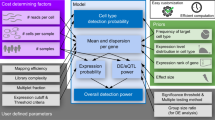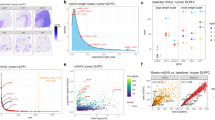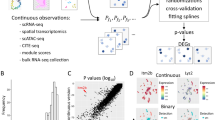Abstract
Microarray technology is now widely available and is being applied to address increasingly complex scientific questions. Consequently, there is a greater demand for statistical assessment of the conclusions drawn from microarray experiments. This review discusses fundamental issues of how to design an experiment to ensure that the resulting data are amenable to statistical analysis. The discussion focuses on two-color spotted cDNA microarrays, but many of the same issues apply to single-color gene-expression assays as well.
This is a preview of subscription content, access via your institution
Access options
Subscribe to this journal
Receive 12 print issues and online access
$209.00 per year
only $17.42 per issue
Buy this article
- Purchase on Springer Link
- Instant access to full article PDF
Prices may be subject to local taxes which are calculated during checkout

Bob Crimi





Similar content being viewed by others
References
Oleksiak, M.F., Churchill, G.A. & Crawford, D.L. Variation in gene expression within and among natural populations. Nature Genet. 32, 261–266 2002
Lee, M.T., Kuo, F.C., Whitmore, G.A. & Sklar, J. Importance of replication in microarray gene expression studies: statistical methods and evidence from repetitive cDNA hybridizations. Proc. Natl Acad. Sci. USA 97, 9834–9839 (2000).
Rosenbaum, P.R. Replicating effects and biases. Am. Stat. 55, 223–227 (2001).
Cox, D.R. The Design of Experiments (Wiley, NY, 1958).
Kerr, M.K. & Churchill, G.A. Biostatistics 2, 183–201 (2001).
Yang, Y.H. & Speed, T.P. Nature Rev. Genet. 3, 579–588 (2002).
Kerr, M.K. & Churchill, G.A. Statistical design and the analysis of gene expression microarray data. Genet. Res. 77, 123–128 (2001).
Brem, R.B., Yvert, G., Clinton, R. & Kruglyak, L. Genetic dissection of transcriptional regulation in budding yeast. Science 296, 752–755 (2002).
Jin, W. et al. The contributions of sex, genotype and age to transcriptional variance in Drosophila melanogaster. Nature Genet. 29, 389–395 (2001).
Simon, R., Radmacher, M.D. & Dobbin, K. Design of studies using DNA microarrays. Genet. Epidemiol. 23, 21–36 (2002).
Quackenbush, J. Microarray data normalization and transformation. Nature Genet. 32, 496–501 (2002).
Yang, Y.H. et al. Normalization for cDNA microarray data: a robust composite method addressing single and multiple slide systematic variation. Nucleic Acids Res. 30, e15 (2002).
Tanner, J. Fallacy of per-weight and per-surface area standards, and their relation to spurious correlation. Appl. Physiol. 2, 1–15 (1949).
Pearson, K. Spurious correlation between indices. Proc. R. Soc. Lond. 60, 489 (1897).
Fisher, R.A. The Design of Experiments 6th edn (Oliver and Boyd, London, 1951).
Slonim, D.K. From patterns to pathways: gene expression data analysis comes of age. Nature Genet. 32, 502–508 (2002).
Kerr, M.K., Martin, M. & Churchill, G.A. Analysis of variance for gene expression microarray data. J. Comput. Biol. 7, 819–837 (2000).
Wolfinger, R.D. et al. Assessing gene significance from cDNA microarray expression data via mixed models. J. Comput. Biol. 8, 625–637 (2001).
Pritchard, C.C., Hsu, L., Delrow, J. & Nelson, P.S. Project normal: defining normal variance in mouse gene expression. Proc. Natl Acad. Sci. USA 98, 13266–13271 (2001).
Callow, M.J. et al. Microarray expression profiling identifies genes with altered expression in HDL-deficient mice. Genome Res. 10, 2022–2029 (2000).
Kerr, M.K. et al. Statistical analysis of a gene expression microarray experiment with replication. Stat. Sinica 12, 203–218 (2002).
Churchill, G.A. & Oliver, B. Sex, flies and microarrays. Nature Genet. 29, 355–356 (2001).
Acknowledgements
Support for this work was provided by the US National Institutes of Health. The analogy of measuring one man and one woman is attributed to Peter Petraitis.
Author information
Authors and Affiliations
Ethics declarations
Competing interests
The author declares no competing financial interests.
Rights and permissions
About this article
Cite this article
Churchill, G. Fundamentals of experimental design for cDNA microarrays. Nat Genet 32 (Suppl 4), 490–495 (2002). https://doi.org/10.1038/ng1031
Issue Date:
DOI: https://doi.org/10.1038/ng1031
This article is cited by
-
Cardiac physiology and metabolic gene expression during late organogenesis among F. heteroclitus embryo families from crosses between pollution-sensitive and -resistant parents
BMC Ecology and Evolution (2022)
-
BMP feed-forward loop promotes terminal differentiation in gastric glands and is interrupted by H. pylori-driven inflammation
Nature Communications (2022)
-
R-spondin-3 induces secretory, antimicrobial Lgr5+ cells in the stomach
Nature Cell Biology (2019)
-
Cluster oligonucleotide signatures for rapid identification by sequencing
BMC Bioinformatics (2018)
-
A pair of datasets for microRNA expression profiling to examine the use of careful study design for assigning arrays to samples
Scientific Data (2018)



